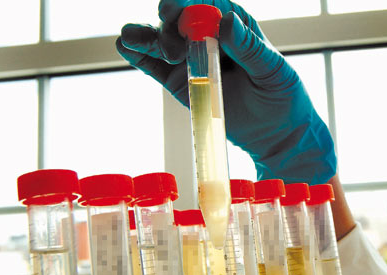 Dipstick screening for protein is done on whole urine, but semi-quantitative tests for urine protein should be performed on the supernatant of centrifuged urine since the cells suspended in normal urine can produce a falsely high estimation of protein. Normally, only small plasma proteins filtered at the glomerulus are reabsorbed by the renal tubule. However, a small amount of filtered plasma proteins and protein secreted by the nephron (Tamm-Horsfall protein) can be found in normal urine. Normal total protein excretion does not usually exceed 150 mg/24 hours or 10 mg/100 ml in any single specimen. More than 150 mg/day is defined as proteinuria. Proteinuria > 3.5 gm/24 hours is severe and known as nephrotic syndrome.
Dipstick screening for protein is done on whole urine, but semi-quantitative tests for urine protein should be performed on the supernatant of centrifuged urine since the cells suspended in normal urine can produce a falsely high estimation of protein. Normally, only small plasma proteins filtered at the glomerulus are reabsorbed by the renal tubule. However, a small amount of filtered plasma proteins and protein secreted by the nephron (Tamm-Horsfall protein) can be found in normal urine. Normal total protein excretion does not usually exceed 150 mg/24 hours or 10 mg/100 ml in any single specimen. More than 150 mg/day is defined as proteinuria. Proteinuria > 3.5 gm/24 hours is severe and known as nephrotic syndrome.
Dipsticks detect protein by production of color with an indicator dye, Bromphenol blue, which is most sensitive to albumin but detects globulins and Bence-Jones protein poorly. Precipitation by heat is a better semiquantitative method, but overall, it is not a highly sensitive test. The sulfosalicylic acid test is a more sensitive precipitation test. It can detect albumin, globulins, and Bence-Jones protein at low concentrations.
In rough terms, trace positive results (which represent a slightly hazy appearance in urine) are equivalent to 10 mg/100 ml or about 150 mg/24 hours (the upper limit of normal). 1+ corresponds to about 200-500 mg/24 hours, a 2+ to 0.5-1.5 gm/24 hours, a 3+ to 2-5 gm/24 hours, and a 4+ represents 7 gm/24 hours or greater.

Advanced Facility Helps Make Exact Diagnosis. View More >>